13 Best Competitor Analysis Tools to Win the Market in 2025
Table of contents
In today’s fast-paced market, knowing what your competitors are up to is essential. Understanding their moves from social media to SEO gives you a competitive edge. With the right competitor analysis tools, staying ahead has never been easier.
Competitor analysis tools gather and analyze information about your industry rivals. These tools can track multiple business areas, such as your competitor domains, marketing strategies, social media, product developments, and pricing updates. Such software helps identify industry trends, benchmark your performance, and position your brand.
Do you ever feel overwhelmed trying to monitor your competitors? Does tracking all their marketing channels drive you to despair?
I totally get it!
Competitive analysis is an all-encompassing project.
Without a dedicated competitive intelligence tool, you’re always playing catch-up.
There are countless KPIs to track: social media presence, brand awareness, business performance metrics, product reputation, online visibility, keyword metrics for SEO… The list goes on.
Remember, competition can make or break your brand.
Discover the best competitor analysis tools now!
What tools can you use to analyze competitors?
There are dozens of competitor analysis tools to choose from. They encompass everything from content strategy to SEO and website performance to social visibility and online performance.
In this article, I want to focus on 5 key areas of the competitor performance analysis, including:
- Brand performance online
- Search engine optimization (SEO)
- Website analysis
- Social media performance analysis
- PPC competitor campaigns research
These tools will give you a marketing mix of insights to understand your competitors’ success and refine your marketing strategy to win the market.
Why do you use competitor analysis tools?
“Knowing who you’re “playing” (aka competing) against is of utmost importance if you plan to win. I strongly recommend that every company pick an “opponent” – a competitor they aim to neutralize within 12 months.
Track their every move and ensure customers have no reason to choose them over you. In practice, this translates into product and marketing roadmap themes like “Neutralize X” and specific metrics tracked against that competitor, such as deal presence, cancellation survey insights, market share, and more.”
Elena Verna, B2B Growth Operator
The 13 best competitor analysis tools
The more you know about your industry, the better decisions you can make.
You should conduct thorough competitor research before engaging in marketing activities or product development.
I’m here to help.
Check out my ranking of the best competitor analysis tools, and never struggle with competitive analysis again.
Best all-in-one AI competitor tools
First, I want to show you a few all-encompassing tools that can make all the difference in your competitor research and analysis.
This business automation software will streamline the analysis of your competitors, providing actionable insights with little to no effort.
It’s a must-have for collecting and analyzing competitor data!
01 Brand24
Brand24 is a media monitoring and social listening tool with advanced AI-powered analytics.
It can help you understand your and your competitor’s market share, compare online performance, listen to potential customers’ voices, and learn your competitor strategies.
With these insights, you’ll discover your weak and strong sides and find a unique selling point.
Companies like H&M, Carlsberg, Uber, Ikea, and Vichy trusted Brand24 for competitive analysis.
Try a 14-day free trial and change your competitive intelligence for good.
Our key feature for competitor research is Comparison. It allows you to compare multiple competitors to quickly asses your marketing performance in context.
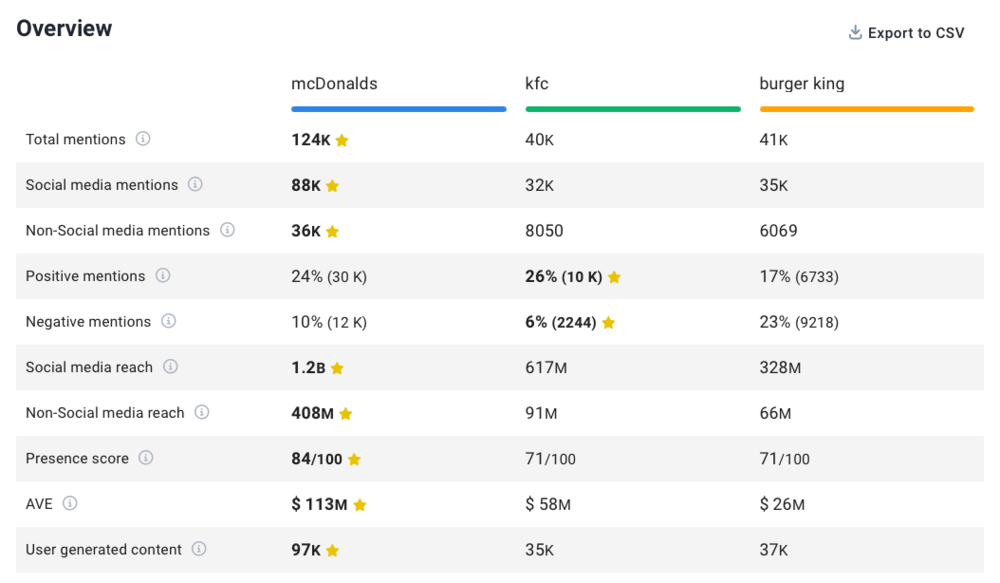
Spy on your enemies with Brand24!
To get more insights or understand the reason behind the numbers, you can use our AI Brand Assistant.
It’s incredibly easy and efficient!
It works like Chat GPT, but better.
Why?
Because it uses data collected through media monitoring to provide truthful and accurate answers.
Prompt: Do a competitor analysis for my brand
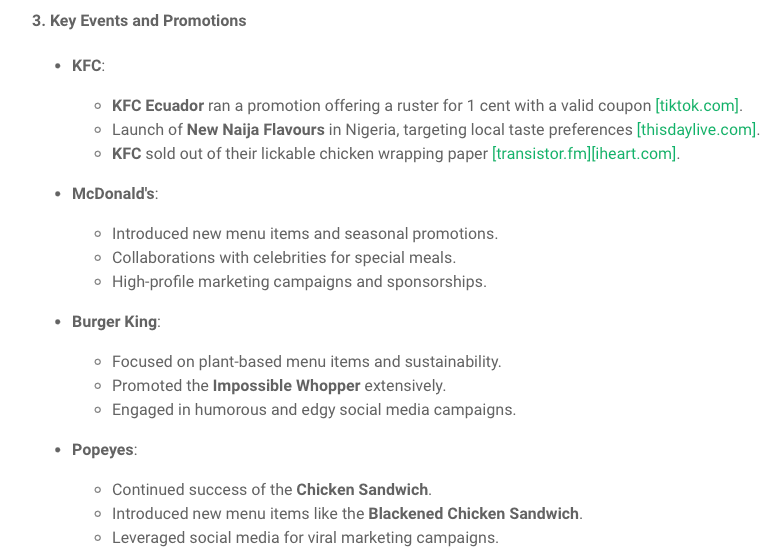
What’s best about this feature is that you can ask follow-up questions to get relevant insights.
You can also ask our AI Brand Assistant to analyze your competitor strategies and craft a marketing strategy to outperform them.
Try the best competitor analysis tool!
And that is just the start.
In your panel, you can find far more competitor insights that will help you identify trends in the market in 2025.
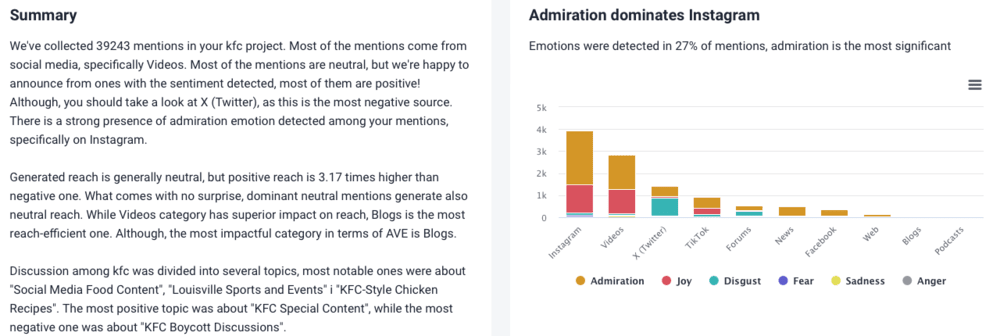
Key features:
- Advanced competitor analysis features and metrics
- Competitors mentions monitoring
- AI Brand Assistant
- Emotion & sentiment analysis
- AI Insights
- AI Anomaly Detector
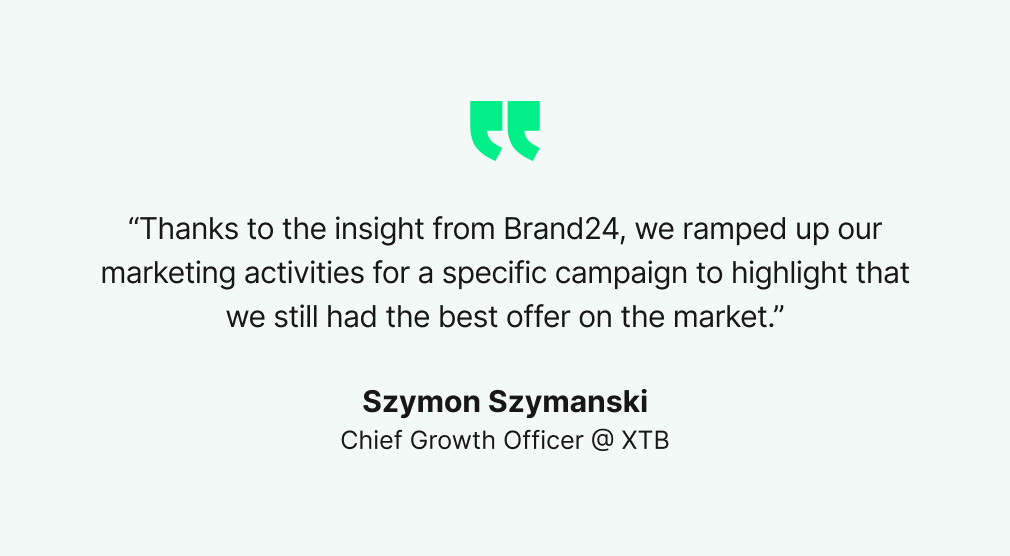
Discover our client’s success story — read the case study.
Overall verdict:
Brand24 is an indispensable tool for brands who understand the importance of online presence nowadays. It monitors brands and their competitors online in real time and calculates advanced metrics to compare companies’ performance and inform your strategy.
Read the XTB case study here
Monitor brand mentions with Brand24!
Strengths:
- Automated & actionable AI insights
- Advanced analytics
- Multiple competitors’ performance comparison
- Broad coverage of online sources
What could be better:
- Limited access to historical data
- Project configuration needed to avoid spam
- Might be pricey for a small brand. However, customized plans are available.
Try Brand24 – the best competitor analysis tool!
02 Kompyte
Kompyte offers real-time competitive intelligence at scale.
It’s one of the competitor analysis tools that tracks your competitors’ websites, reviews, content, social media posts, ads, job postings, and more!
You can then find all those insights in comprehensive dashboards with comparison options.
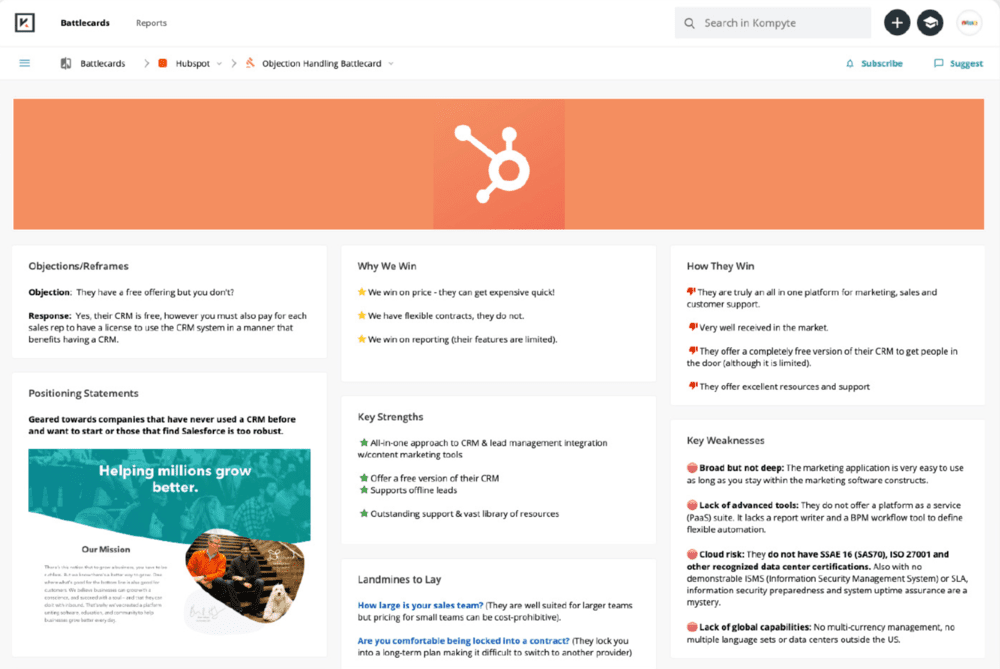
Their unique feature is battle cards.
These are competitive analysis dashboards that facilitate comparison. They include pricing, strengths, kill points, and other valuable insights about your competitor strategies.

This competitor research tool ensures an all-encompassing approach to your analysis. Thanks to AI, it can ignore the spammy buzz and focus on key insights.
Some of the best Kompyte features include automated workflows and analytics with market research tools. They guarantee in-depth insights and a complex approach to competitor analysis.
Track competitors with Brand24!
Key features:
- Automated workflows
- Competitor research and analytics tools
- Battle cards
- Win/loss and SWOT analysis
- Deal winning insights
Overall verdict:
Kompyte is an interactive board that collects competitor data in one place. It’s perfect for sales teams looking for unique product selling points and marketing teams thanks to comprehensive data about competitors’ online.
Strengths:
- Clear visual representation of the brand’s competitors.
- Broad scope of competitor monitoring, including changes on their website.
- All-encompassing competitor research tool.
What could be better:
- No first-hand insights from your competitors’ audiences due to a lack of media monitoring capabilities.
- No chatbot feature limits the option for extra questions.
SEO competitor analysis tools
SEO analysis is the cornerstone of your brand’s success online.
Unless you position well in the search engines, you won’t be visible to your target audience. Thus, nobody will find your website, especially if your competitors rank higher than you do.
03 Semrush
You say SEO. You think Semrush.
Semrush is a great keyword research tool for SEO competitor research, particularly if you want to compete for users in Google search.
The quality of your website’s content and technical performance determine its visibility in search engines for potential customers.
Semrush is the right tool for screening your competitor’s website’s SEO performance and managing your search engine performance.
Top organic keywords are among the most valuable pieces of data about your competitor you can get from Semrush.
Here, you can see the keywords your competitor ranks for particular URLs.
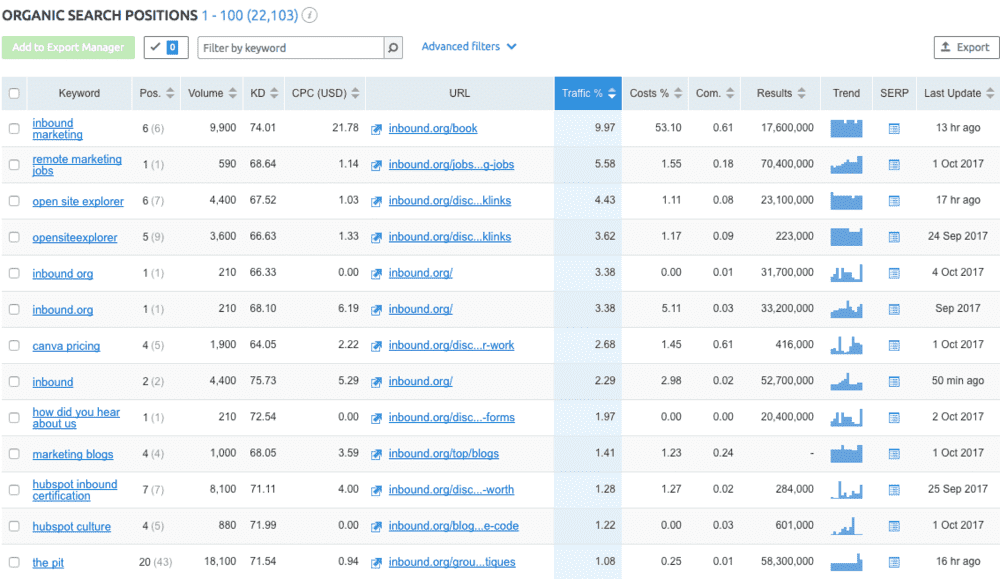
In backlinks, you can see all sites that link to your competitors’ websites:
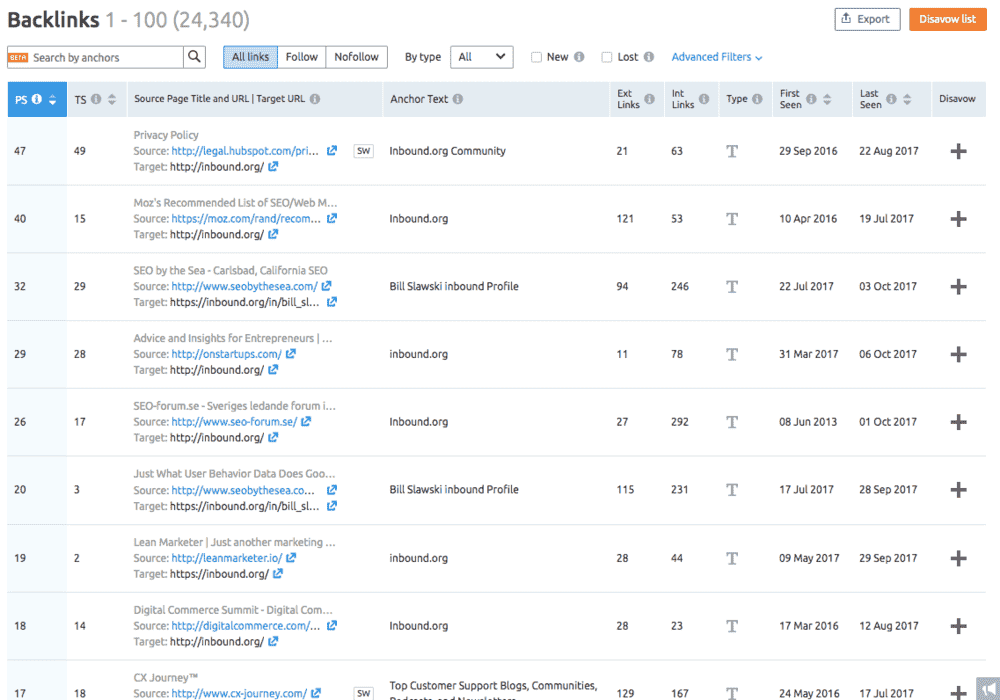
How can you use this knowledge?
For example, you can contact sites linking to your competitor’s websites and ask them to mention your site as well.
Backlinks give a massive boost to SEO and increase online visibility.
Moreover, the data from Semrush can inform your SEO strategy.
Based on these insights, you can conduct a content analysis and develop a keyword planner for your content distribution.
Key features:
- SEO competitor research
- Traffic volume and source detection
- Organic, paid, new, and lost keywords identification
- Backlinks monitoring
- Keyword trend analysis
- SERP insights
Overall verdict:
Semrush is a versatile SEO competitor analysis tool. It is perfect for mid-size and big companies that want to collect competitor SEO data. Besides SERPS analysis, Semrush offers features for complex competitive analysis.
Strengths:
- Competitors’ keywords research support
- SEO competitive benchmarking
- Intuitive dashboard
What could be better:
- Pricey for a small business or startup.
04 Majestic
Majestic is one of the competitor analysis tools focusing on backlink data. It helps businesses understand and improve their online presence.
By analyzing your website’s and competitors’ backlinks, Majestic provides insights into the quality and quantity of links, which are crucial factors in search engine ranking.

One of Majestic’s key uses is identifying the strength of a competitor’s backlink profile. It shows you where your competitors are getting their links from and the authority of the linking sites.
This can reveal opportunities for building similar or better-quality links to improve your own search engine rankings.
Majestic also offers detailed metrics like Citation Flow and Trust Flow, which measure the influence and trustworthiness of your website’s backlinks.
Comparing these metrics with your competitors helps you understand where you stand regarding link quality and authority.
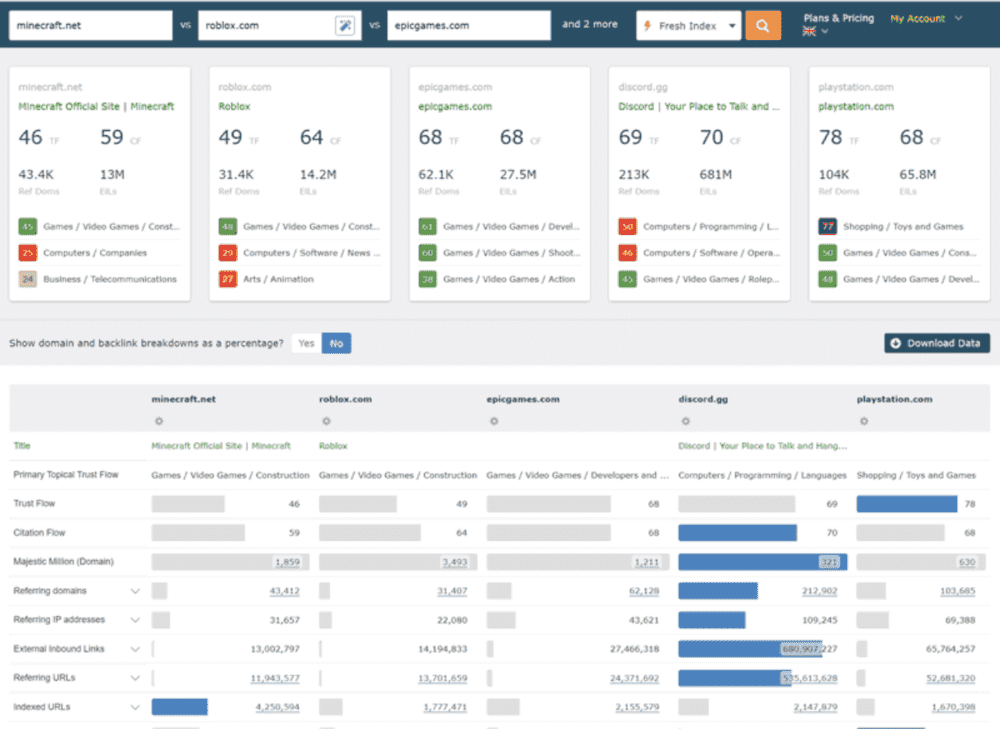
Additionally, Majestic’s backlink history feature shows how a competitor’s link profile has grown or declined over time.
This insight is valuable for identifying successful link-building competitor strategies or spotting potential weaknesses in a competitor’s approach.
Key features:
- Backlink and website analysis
- Metrics like Citation Flow and Trust Flow
- Link-building support and reporting
Overall verdict:
Most Majestic users come from the marketing and advertising industry and especially appreciate the tool’s ease of setup and admin. Majestic is a cheaper alternative to Semrush, making it attractive for small businesses. However, according to G2 reviews, Majestic is rated worse than Semrush, so user satisfaction drops along with the price.
Strengths:
- Detailed reporting
- Tracking results in time
- Historical backlink data
What could be better:
- Data inaccuracy
- Limited features
Why do you use competitor analysis tools?
“I use competitor analysis tools to see what others are doing and where there’s room to stand out. It helps me understand content patterns, audience reactions, and positioning tactics. It’s a quick way to check if you’re leading, lagging, or missing an opportunity altogether.”
Phil Pallen, Brand Strategist
Website competitor analysis tools
Your website is the meeting point between you and your customer.
Thus, it creates a great opportunity to get to know your clients, analyze trends, and get consumer behavior insights.
05 Google Analytics
Google Analytics is an essential tool for competitor analysis. It offers detailed insights into website performance and user behavior.
Google Analytics helps businesses understand where their traffic comes from, such as organic search or social media, and compare this to industry benchmarks or competitor data to identify successful strategies.
The tool provides demographic information about users, such as age, location, and interests, allowing businesses to see how their audience compares to competitors. This allows you to differentiate and establish your unique selling point.
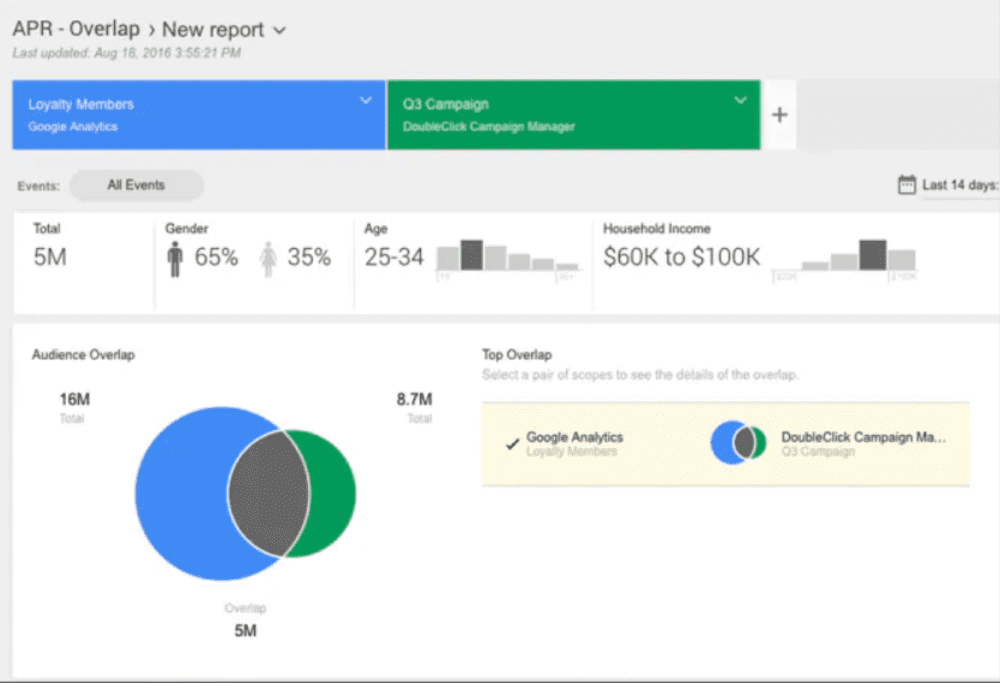
Additionally, Google Analytics tracks user behavior on a website, such as which pages are visited and where users exit.
This data can reveal areas where a website may underperform compared to competitors, guiding optimization efforts.
Conversion tracking in Google Analytics is also crucial. It shows how effectively a website converts visitors into customers and offers insights into the sales funnel’s strengths and weaknesses.
Spy on your enemies with Brand24!
Key features:
- Detailed traffic sources
- Demographic insights
- Behavioral data
- Conversion tracking
Overall verdict:
While Google Analytics is mainly dedicated to analyzing your own site, it can also be useful for examining competitor domains. To achieve the best results, use Google Analytics together with SEO competitor tools like Semrush, Similarweb, or Ahrefs.
Strengths:
- Advanced market research tool and data analysis
- Benchmarking reports
- Marketing channels performance insights
What could be better:
- Complex dashboard that is hard to grasp and navigate at first.
- Costly for a small business
Social media competitor analysis tools
Social media is one of the most important touch points with your audience.
Creating competitive content and engaging with influencers helps improve social media visibility and outshine competitors.
You just need social media marketing tools and a great content strategy.
06 BuzzSumo
BuzzSumo is a social media analytics tool. It handles influencer marketing, content marketing, PR performance, and analysis of your top competitors’ social media posts.
With BuzzSumo, you can discover your competitors’ social insights, including:
- Networks that share their content
- How your content compares
- Most effective content types
- Engagement metrics
- Most shared content analytics

Highly shareable content in social media has a few advantages:
- It increases brand awareness and recognition.
- It signals that the content is valuable as it sparks interest among readers and encourages them to share the value with others. This motivates the social platform and Google to boost your content’s online visibility.
With BuzzSumo’s help, you can easily detect the parameters of shareable content in your niche.
Additionally, BuzzSumo offers a Facebook Page Analyzer. This tool provides detailed insights into your competitor’s Facebook performance.

BuzzSumo is also a media monitoring tool because you can receive alerts whenever your competitor is mentioned online.
Key features:
- Social media monitoring and analytics
- PR performance monitoring
- Influencer marketing
- Competitors content analytics
- Facebook Page Analyzer
Overall verdict:
Buzzsumo is a great tool for companies that create content on Facebook, X (Twitter), Pinterest, and Reddit. If you post a lot, you’ll appreciate the one dashboard from which you can monitor your competitors and your own performance, compare metrics, and schedule content.
Strengths:
- Facebook Page Analyzer
- Content distribution and competitors’ content analytics in one dashboard
- Content ideas
What could be better:
- Data inaccuracy
- Content and analytics issues
- Geographic bias
- Pricey for small businesses
07 Sprout Social
Sprout Social is a social media management tool that supports competitive analysis. It offers competitive benchmarking of key business metrics, including brand health, social presence, engagement, and impressions.

With Sprout Social, you can track the following metrics of your competitors and compare them side by side with yours:
- Share of Voice
- Engagement
- Impressions
- Unique Authors
- Sentiment

Sprout Social also offers insights into your competitor’s content marketing, which you can use to inspire your own content strategy and develop catchy content ideas.
Sprout Social is a bit similar to Brand24 because it tracks online conversations and sentiment metrics.
What is the difference between Brand24 and Sprout Social?
While Brand24 analyzes your competitors holistically, Sprout Social focuses mostly on your competitors’ content and offers limited audience insights.
Sprout Social falls behind because of a limited number of metrics and an absence of AI-powered insights and features.
Because of this, it may lack the depth of understanding as it works on raw data without calculating complex metrics, detecting correlations, and finding patterns.
Use Brand24 to keep an eye on your competitors!
Another area where Brand24 has a competitive advantage is G2 ratings. Users say Brand24 is better than Sprout Social in all rated categories.
But let’s be fair.
Sprout Social has a few features that Brand24 doesn’t cover.
These are traffic analysis (paid vs organic) and team collaboration functions like case assignment.
Key features:
- Basic metrics monitoring
- Conversations monitoring
- Sentiment analysis
- Traffic analysis
- Team collaboration features
Overall verdict:
While Sprout Social is a comprehensive social media management platform, it might not be the best for competitor benchmarking. For this use case, the tool offers limited features centered around simple metrics that can be compared.
Strengths:
- Multi-channel social media management with post scheduling
- Intuitive dashboard
What could be better:
- Lack of useful features resulting in the need to switch between several tools.
- Issues with the content scheduling feature
- Pricey for the value
08 Hootsuite
Hootsuite is one of the most recognized social media analytics tools. It monitors the performance of business profiles on 35 social media platforms.
With this competitive intelligence tool, you can track your competitors’ social media activities, draw unique conclusions, and make data-driven decisions regarding your own business strategy on social media.
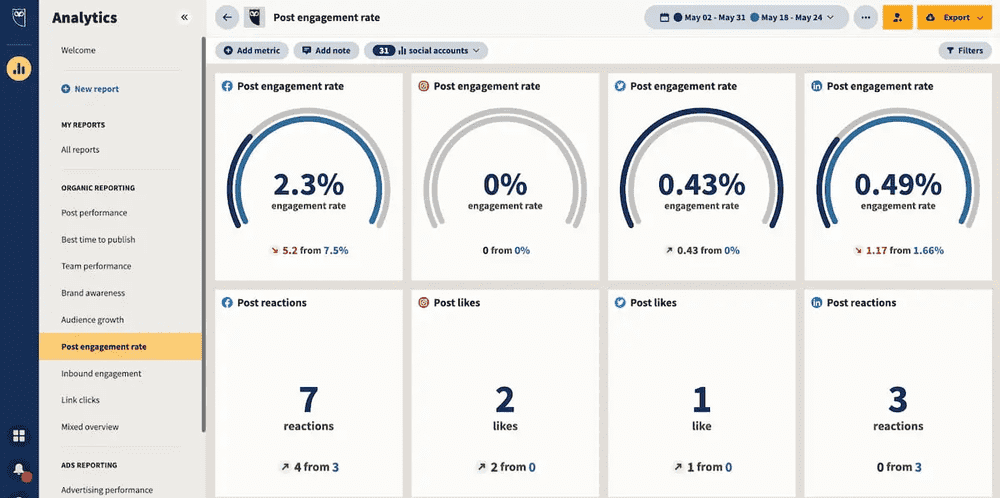
You can see how your competitors engage their communities, what content they post if they run contests, and how their marketing campaigns resonate with their audience.
This competitive analysis tool gives detailed insights into your competitor’s posting strategy and audience reception.
This way, you know what works for their audience and can leverage this information to build your marketing strategy.
Hootsuite also offers keyword and hashtag research and tracking.
Key features:
- Competitor’s posts insights
- Hashtag and keyword tracking
- Competitor’s marketing strategy analysis
Overall verdict:
Hootsuite is an effective platform for managing multiple social platforms from one centralized dashboard. It’s perfect for companies active on social media and posting across different platforms.
Strengths:
- Centralized management
- Intuitive dashboard
What could be better:
- No post scheduling on Instagram and X (Twitter)
- Pricey
PCC competitor analysis tools
PPC campaigns are another key area where you can win against your competitor websites.
The plan is easy: You discover and analyze your competitors’ paid strategies and build more effective marketing campaigns than theirs.
Sounds simple?
It is – with the right tools.
09 Spyfu
Spyfu is one of the competitor analysis tools that can help you gain insight into your competitors’ paid traffic.
The tool shows you what paid keywords your competitors currently rank for and ranked in the past. Spyfu also provides keyword research tools and suggestions based on your target market trends.
One of Spyfu’s best features is sorting keywords by cost per click to discover quick wins.
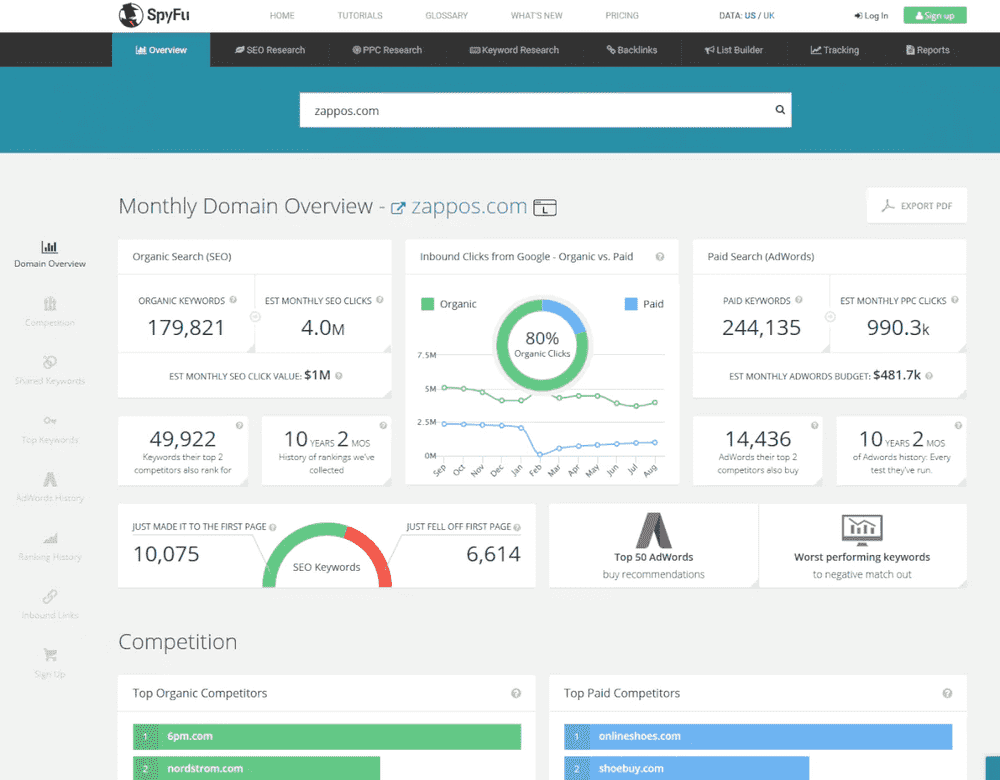
Thanks to its CPC analyzer, you can easily find quick SEO wins and outperform your competitors in a flash.
Additionally, Spyfu provides backlink insights and detection of linking opportunities. By leveraging this feature, you can create a backlink strategy and boost your position in organic search as well.
Conduct competitors research with Brand24 now!
Key features:
- Recognizing threats
- Tracking your competitors’ changes in ad spending
- Suggestions for keyword groups
- CPC analyzer
- Market research
- Backlinks builder
Overall verdict:
Spyfu is a useful tool for startups wanting to start their battle in paid search and for companies looking for quick market wins. With Spyfu, you can quickly improve your brand visibility online and outperform your competitors’ keywords.
Strengths:
- Keyword research
- Competitive analysis
- Great customer support
What could be better:
- Inaccuracy
10 SE Ranking
Over 500,000 users chose the SE Ranking to get comprehensive SEO tools to audit and improve their websites’ performance.
Whether you want to start a new business or gain an advantage in your industry, competitor and keyword research is your starting point.
You can use SE Ranking’s competitive analysis tool to reveal your rivals’ organic and paid marketing strategies.
For example, you can find competitors’ keywords that drive traffic, conduct backlinks monitoring, and spy on Google Ads marketing campaigns.
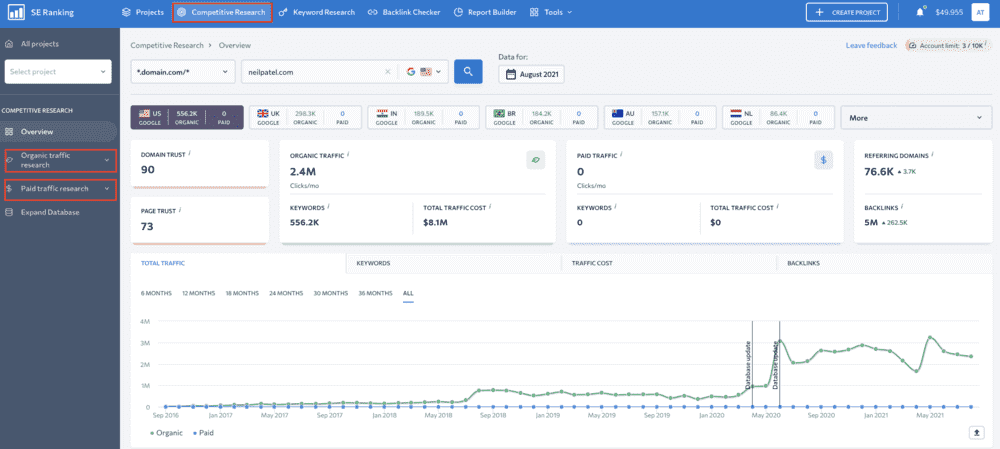
SE Ranking allows users to analyze domains and keywords from back to February 2020.
You can check changes in website traffic, keywords, and backlinks by selecting a month and a year.

How can you get an advantage using this feature?
By analyzing competitor performance in dynamics, you’ll get valuable insights about:
- Changes in the target market
- Traffic drops and the reasons behind them
- Effective practices of competitor’s promotion strategies
- PPC competitor research of best-performing keywords
Based on the comprehensive SEO competitor analysis with SE Ranking, you make more thoughtful SEO decisions and promptly respond to market changes.
Key features:
- Domain and page trust
- Traffic cost and estimate
- Backlinks & referring domains
- Keyword rankings
- Distribution of organic and paid competitors’ keywords
Overall verdict:
SE Ranking is a useful tool for tracking SERPs, link building, and SEO analysis of your competitors. Its great asset is its flexible subscription plans, which allow you to pay only for the exact amount of data and features you used. This makes it a perfect solution for companies of all sizes.
Strengths:
- Historical data
- Flexible subscription plans
What could be better:
- Limited features
- Inaccuracy
- Pricey
Conduct competitors research with Brand24 now!
Free competitor analysis tools
Do I have any budget-friendly options for you?
Of course, I do!
Check out my favorite free tools for competitive analysis.
11 Similarweb
Similarweb is a go-to tool for search traffic analysis. More can be found in the paid version.
With this free tool, you can gain the following insights:
- Volume of traffic: estimation of how much traffic your competitors get
- Sources of website traffic: paid acquisition, referral, or organic traffic
- Ad display insights
To compare the performance of your website to your competitor’s, enter your site address first.
Next, paste your competitor’s web address:
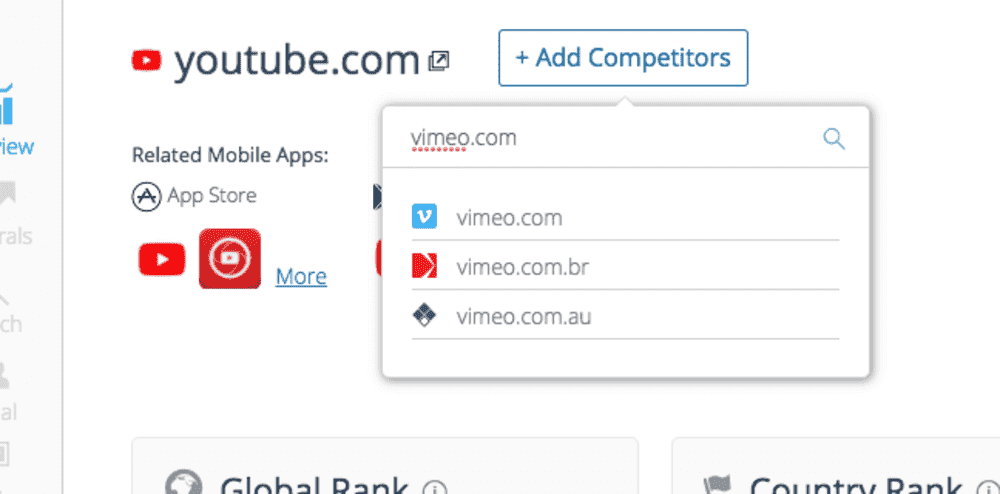
In the free version of the tool, you can see global, country, and category rank:

Also, the free version of Similarweb offers a traffic overview and site traffic sources.
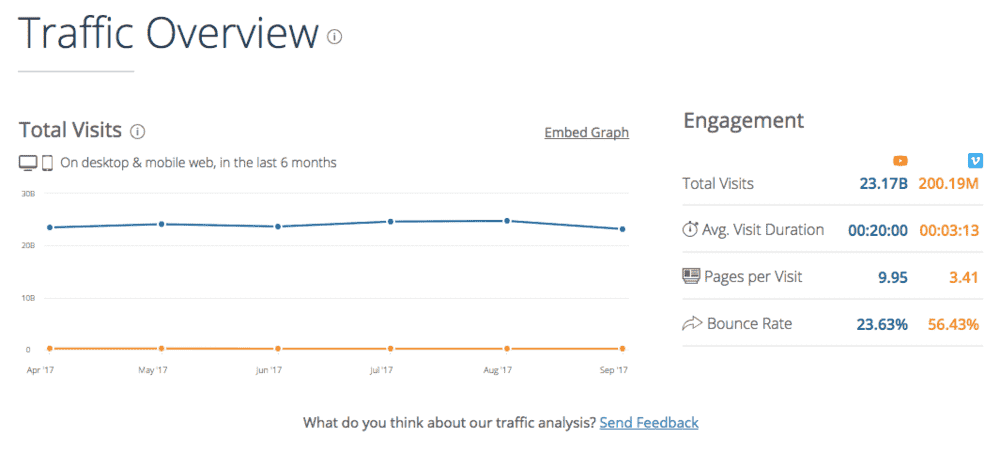
With this feature, you can see the differences between you and your competitors based on traffic sources. This way, you can make informed strategy decisions.
For example, if your competitor performs well in organic traffic, you can concentrate your marketing efforts on social traffic or try to compete by writing a competitive blog post.
Competitor analysis tools? Try Brand24.
Key features in the free version:
- Referrals insights
- Traffic volume and sources benchmarking
- Ad display insights
Overall verdict:
Similarweb is a great tool for small companies with a tight competitor monitoring tools budget. While the features in the free version are pretty limited, it’s better than nothing, right? And if you like the basic features, you may eventually go for a paid plan and get complete insights.
Strengths:
- Free plan
- Traffic analysis
- Competitor insights
What could be better:
- Limited features in the free version.
12 Ahrefs
Ahrefs is an SEO strategy analysis tool with a free version available.
You can use it to compare your positioning with your competitors’s metrics, including:
- Search volume
- Keyword difficulty
- CPC
- Position
- Traffic volume
- Domain Rate

So, how do you identify SEO competitors?
- Go to Site Explorer
- Paste your domain URL
- Enter the Organic Competitors tab
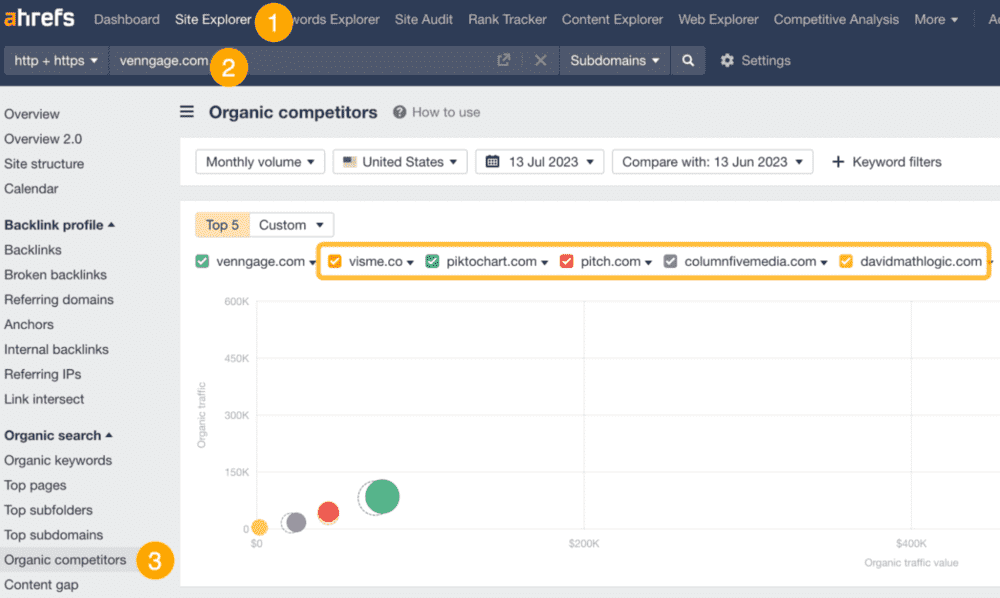
With the simple visual representation, you can easily discover your biggest competitors and compare your performance over time.
Additionally, you can use Ahrefs for:
- Your competitors’ traffic sources and locations investigation
- Backlink and content gap detection
- Identification of your competitors’ featured snippets in Google search
Key features:
- Site Explorer & Audit
- Backlink and content gaps detection
Overall verdict:
Ahrefs is a great starting point. If you are a website owner wanting to monitor your website’s health, keywords, and backlinks, Ahrefs will be perfect for you.
Strengths:
- Free plan
- Keyword & backlink research
What could be better:
- Limited features in the free version
- Inaccuracy
- Pricey paid plans
Spy on your enemies with Brand24!
13 Google Trends
Google Trends is a powerful tool for competitor analysis, providing real-time and historical data on search behaviors.
It allows you to compare your brand’s search volume against competitors’. This offers insights into relative brand awareness and market presence.

The tool’s geographical insights help identify where competitors are strong and weak, guiding targeted marketing efforts.

Google Trends is also essential for spotting emerging trends by tracking rising or declining search terms. This way, you can stay ahead of market shifts and uncover seasonal patterns in consumer interest. With this insight, you can guide the timing of your promotions.
Additionally, the tool suggests related queries and topics, helping you understand shifts in consumer preferences, get content ideas, and identify content gaps to win with your competitors.
Key features:
- SEO auditing
- SERP rank tracking
- Regional interest data
- Related queries and topic suggestions
Overall verdict:
One of the G2 reviews says, “It’s a simple and intuitive tool available to everyone.” I couldn’t agree more. It’s going to be a perfect solution for SEO competitor research, especially for a small business.
Strengths:
- Free version
- Keyword research for content ideas
What could be better:
- Limited insights and features
- Geographical limitations – not all countries’ trends can be precisely tracked
Conclusion
Competitive analysis is a must-have these days.

What competitor analysis tool should you choose?
There is no one-size-fits-all solution.
Detect the most strategic areas for your business. Focus on closely monitoring them and gaining a competitive edge in those key niches.
Competitive analysis will bring you marketing data about your rivals. It will help your business become an industry leader in many different fields, including SEO, website performance, social media, and PPC.
Whether you want to increase market share or check your competitive landscape, I recommend using a dedicated tool to make the process easier and more effective!
Key takeaways:
- Competitor analysis tools are your key to becoming a market leader. They track and analyze your performance and compare it with your competitors.
- Take a complex approach to competitor analysis. Remember that there are multiple areas to monitor. Detect the strategic ones for close examination.
- In today’s digitally oriented business world, tracking your competitors’ online activities is crucial. Try Brand24, a professional media monitoring tool, to stay informed about your competitors’ online performance metrics and their audience’s reception.
Try the best competitor analysis tool!
Related articles


![Context Analysis: Everything You Need to Know [2025]](https://brand24.com/blog/app/uploads/2022/06/Context-Analysis-1.png)

![How to Make a Competitive Analysis Report [Template + Examples]](https://brand24.com/blog/app/uploads/2024/04/comp_analysis_report-600x335.webp)